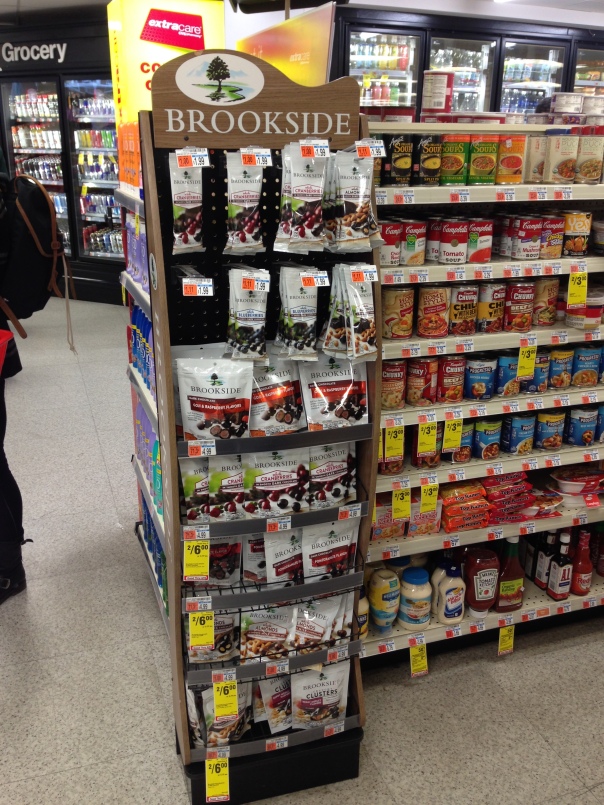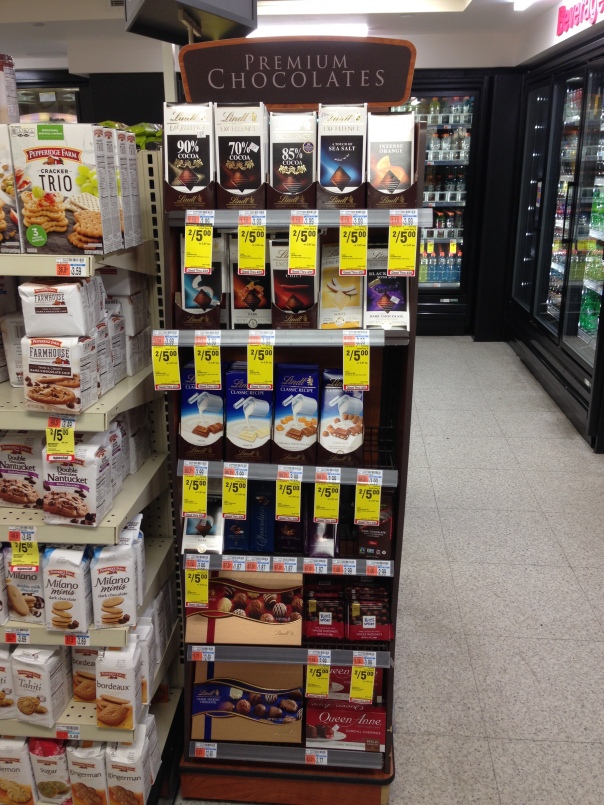“Taste, here, is an autonomous force that affected, rather than reflected, discourse.”
Marcy Norton, in discussion of chocolate’s evolving composition (p. 691)
Tangibly, what we might intend by ‘chocolate’ is a broad, non-essentialist, amalgamated foodstuff; it is composed of myriad ingredients, none of which need necessarily be present in order for it to be known as such – with the possible exception of that core ingredient, Theobroma cacao (pictured above); it is “chemically complex, containing many potentially pharmacologically active compounds” and yet there is little in the way of consensus in the sciences or in the humanities as to what precipitates its elevated status among foodstuffs (Benton, p. 213) – a status complicated all the more by the great uncertainty as to what one actually intends by ‘chocolate’. There is ongoing research into the fundamental effects of neurochemicals contained in cacao, the actual content of which, in white chocolate for instance, may be negligible; how chocolate in its tangible form, or indeed as a psychosocial construct, might influence brain chemistry is likely to remain a research area fraught with moral hazard, given the normative judgements, claims, and aspersions more than likely to be elicited from competing interest groups in Big Food, consumer groups, democratically elected governments looking to legislate on nutrition, et cetera… These are particularly shaky foundations on which to attempt to construct some sort of accorded or objectivised truth, and indeed there continues to be a stark lack of consensus in scholarly circles with regards the neurological effects of cacao (Benton, p. 205). Thus this essay takes the behaviour of chocolate consumption, in a rather general and somewhat specious manner, as a behaviour transmitted socially and as that alone, not intending to cast any normative judgements thereupon but to deconstruct various intrinsic and extrinsic characteristics of ‘chocolate’ the concept and the object of consumption which might single it out. The objective is thus chocolate decentred, debased, and a formless tool for memetic analysis of our consumption habits.
Model of Transmission
A behaviour born in the Amazonian basin millennia before Christ (Coe, p. 24), the spread of cacao consumption, in its broadest sense, would suggest a powerful intergenerational, and indeed intercultural, process of transmission. A foundational view of human ethology is the Platonic understanding of behavioural acquisition by the unending and omnipresent process of mimesis, or emulation (Stanford) – one learns of a behaviour by witnessing it and repeating it after assimilation and simulation in the brain. One can similarly understand this process as the memetic transfer of cultural information, the transfer of a meme (the intellectualised unit represent of the behaviour) from one individual to another and thus its transmission (see video below). One experiences this first-hand in the raising of a child, or simply in the development of close relationships, as humans are preternaturally disposed to mimesis of the bodily comportments of others – one can likely divine whence one inherited one’s own particular tastes, idiosyncrasies, and predilections (perchance chocoholism?).
https://video-api.wsj.com/api-video/player/iframe.html?guid=5C1154F8-36EB-4797-AFE9-C60226055FB1
Richard Dawkins on the ‘Cultural Meme’, Wall Street Journal
In this context, and a conception of his contemporary capitalistic society, the sociologist Thorstein Veblen posited that emulation is the chief determinant of taste – that one inherits tastes from the powerful classes, assimilating their mores out of a Dawkinsian survival instinct (Veblen, pp. 112-17). Chocolate still enjoys a status as a treat or luxury, some of that New World mystique and allure often lavished on its marketing, whilst the average individual in a western nation consumes roughly 10lbs or more per annum (Forbes). Veblen would argue that this alliance of one’s behaviours, and by extension one’s identity, to the trendsetting classes, ie. the colonial elites who first adopted the drinking of chocolate as a delicacy, would be out of prudence in a competitive social environment and thus serve a specific function. This is a view in line with that of cultural sociologist Pierre Bourdieu that taste is the conformity of subjective pleasures to social hierarchies (Sulkunen, p. 112). It would not be a stretch to link these conceptions of memetic transmission as subservient to socio-political order, and not simply informative thereof, to the Marxist or otherwise materialist understandings of the exigences of economy and how profit incentivises, ie. differential rates of taxation, which have dictated the relative fortunes of chocolate, or rather cacao, and other drug-foods such as coffee or tea (p. 185-186).

Molten chocolate, muthscandy.com
Cultural historian Marcy Norton criticises the ‘functionalist’ perspectives detailed above for their invention of the rational consumer – who behaves according to economic and biological, perhaps genetic, imperatives. Norton similarly dismisses certain more qualitative explanations which suggest ethical, normative explanations for shifts in consumption behaviours. She holds that it is not the purpose of objects but their actual use that is of import, whilst supposedly attempting to address the ‘why’ as opposed to ‘how’ chocolate consumption evolved (Norton, pp. 661-664). Yet, the more post-structuralist aspects of her thinking, with regards eschewing qualitative understandings of the consumer, marry well with conception of the sociocultural functionality of taste as transferred memetically, albeit confined to the Cartesian lines of economic and biospherical exigence. Thus cultural-functional, emulative, materialist, and indeed psychopharmacological models (to be explored below) can be triangulated in the, unconnoted, notion that behaviours such as chocolate consumption, and indeed the very conception of ‘chocolate’ itself, are cultural information diffused by memetic transfer.
Yet, establishing an inoffensive theoretical model for how chocolate-related concepts and behaviours, or simply chocolate-related ‘memes’, are transferred offers no insight into what information is actually coded therein. In like cultural contexts to that in which this author has lived, chocolate is likely far more readily associated with the image of molten chocolate above, at least symbolically; that is, to the complex, recombinant form that has evolved over centuries, been embellished upon almost so much as it that normalised silky, conched, tempered form – as opposed to molten, note, though recognisable all the same – is still systematically erred from today. It is almost so wholly abstracted from the base plant as to render cacao, pictured below, all but unrecognisable to the average consumer. In order to understand the social transmission of chocolate consumption, one must look at the polymorphous conception of chocolate that is coded, in its intrinsic and extrinsic complexities.

Sliced cacao pods, public domain
Content of Transmission
The experience of cacao consumption is not only a product of that behaviour’s transmission, but necessarily its precedent. Consumption of a foodstuff is the exemplification of a subjective experience and, as such, despite the fact that the behaviour may be replicable, and indeed often enacted socially and thus easily transmitted and replicated with a degree of specificity, attempts by researchers to construct metrics thereupon are doomed to be disappointingly lacking in insight (eg. Stuckey, pp. 136-137). Strictly gustatory experience, ie. taste only as experienced via the tongue in exclusion of other senses and neurological activity, has fewer variables at play and indeed the great sweetness and fattiness of some chocolates has been shown, though clearly not then representative of large swathes of that which falls under the moniker ‘chocolate’, to stimulate reward circuitry in the brain – ie. prefrontal activity indicative of mesocorticolimbic dopamine activation (Benton, pp. 213-215). Yet even one’s taste buds, the transductive receivers which convert molecules to electrical signals and neurochemicals that communicate information to the gustatory cortex (whose role is explained in the video below), do not work in isolation of other senses. They also vary, and not only from person to person, ie. in their combined constitution. In the individual’s own lifetime their taste buds evolve unto adulthood (Stuckey, p. 21). This only nods towards the potential epigenetic influences of tastes, themselves received and thus reinforced or augmented by memetic transfer – a good example would be how a child may have a sweet-tooth, partly due to exposure to high levels of cortisol in the womb, or to displays of stress in early life which predisposes a calorific diet, who in later life develops more savoury tastes and so alters the memes, and indeed genes, they would otherwise have transmitted to their own progeny (Cornell; NCBI). One can clearly see the application of this analogy to patterns of chocolate consumption and the potential for individuation thereof.
The Science of Taste – KQED QUEST
In addition to the strictly gustatory elements to the ‘taste’ of chocolate, there are the important effects of trigeminal nerve stimulation, ie. sensation of texture, pain or spice, and temperature, which are crucial to pleasure in eating. Additional elements, elaborated upon in the video above, concern not simply the olfactory, and other sensory data, but cognitive and emotional memories and associations – “enjoyment of emotions as summoned through imaginary or illusory images [as] central [to] pleasure” (Colin Campbell in Norton, p. 663). The totality of these elements together with ‘taste’ itself forms what is distinguished in the video therefrom as ‘flavour’.
In the consumption of a foodstuff there is major influence of other pre-coded aspects of human psychology, not simply immediate, tangible phenomenology – food developer Barb Stuckey argues that the sound of tempered chocolate cracking, qualitatively, is a key element in the presentation of, and in turn key to the preconceptions and thus eventual satisfaction a consumer has for, a chocolate product (Stuckey, p. 140). These ad hoc influences on one’s perception of a particular chocolate, if not ‘chocolate’ conceptually or behaviourally, add a great deal of complexity to the relationship of individuals to that particular object of consumption. And one’s enjoyment, indeed investment in, the momentary experience can be almost completely distracted, voided, or drained of pleasure (and thus likely otherwise altered or influenced) by dramatic ongoings in the environs – as described by Stuckey with regards how a couple’s spat at the next table utterly precluded her from investment or pleasure in her meal (pp. 132-133).
Given that the complexity of ‘flavour’ as a concept and experience is not limited to the concept or experience of chocolate alone, chocolate’s special status as an indulgence and yet in ubiquity, its elevation culturally, and enduring appeal have suggested some peculiarity thereto. As detailed at the start of this essay, there is not an agreed scientific explanation, indeed while there are a number of psychoactive chemicals such as phenylethylamine and methylxanthines caffeine and theobromine, as well as the serotonin-producing reservatrol and tryptophan, they all appear in far too low quantities to wholly explain widespread archetypes of the ‘chocoholic’ or the archetypal behaviour or ‘craving’ chocolate (Benton, pp. 209-212). A more comprehensive explanation is that the high correlation between pleasurable food intake and the release of endorphins, peptides which act on opioid receptors, is true of chocolate consumption (pp. 212-213). If one couples this with the dopamine activation described above then one can understand a major aspect of repeated chocolate consumption as dependent on one’s perception of chocolate as opposed to the inherent nature of the product itself – thus the great influence of information culturally conferred with regards to chocolate.
Multisensory factors do not end with those extrinsic elements of the experience, ie. the cultural context in which one consumes chocolate or the packaging and presentation, but extend to the temperature of the room one is in, the ambient noise-level, present company, weather, and so forth – and early experiences, within context, write scripts for future experiences in the associations they entail (Psychology Today). If one were to use the analogy of coffee and coffeeshops, the texture of the mug used, even the colour of that mug (Flavour Journal), the cultural construct of drinking from a mug at all, or indeed the fundamental construct that coffee, as opposed to maté or indeed chocolate, should be the warm beverage chosen; these are all examples of the complex psychology at play, influencing our perceptions and the manner in which we code concepts and behaviours memetically transmitted. In turn, those codifications inform the memes we pass on to others, here as pertains to our consumption patterns, in which the effects of theobromine content or ‘the catchy song playing in the background on the radio in the trendy coffeeshop where first I tried a white hot chocolate’ fade to one of legion infinitesimal inputs that construct the meme as it is held in the individual.
The counterpart to Plato’s mimesis, however, was diegesis, or ‘narrative’ (Stanford Online), and while this essay was intentionally aimed at deconstructing some of the intrinsic and extrinsic elements of chocolate as it is conceived and experienced, admittedly in a roundabout and haphazard fashion, it has been at the cost of any narrative sense as to what chocolate really is. Indeed, if one is to utterly debase and decentre one’s concept of what exactly a product is or should be – as has hopefully been achieved in this essay thus far – one is able to open consumers up (or is oneself opened up, dependent one’s role in the power dynamic in play) to the wholesale transfer (or adoption) of metanarratives. As so often becomes of highly mature consumer industries, as they slip towards conspicuous consumption and what one might term becoming ‘Veblen goods’ (pp. 33-48), there is developed a sense of ‘terroir’ and producers attempt to directly control the memetic transfer of conception as well as ritual, ie. all the multisensory facets to the psychological experience of consumption as detailed above. Thus there is the attempt to tailor experiences, alter transmission and construct the product, in this case chocolate, directly as opposed to leaving the interplay of transient socioeconomic, cultural, and biospherical factors reach equilibrium unaided.
Works Cited
Benton, David. “The Biology and Psychology of Chocolate Craving”. Coffee, Tea, Chocolate, and the Brain. Boca Raton: CRC Press, 2004.
Coe, Sophie D. and Michael D. Coe. The True History of Chocolate. London: Thames & Hudson Ltd., 2006 (3rd Ed).
Mintz, Sidney W.. Sweetness and Power: The Place of Sugar in Modern History. London: Penguin Books Ltd., 1985.
Norton, Marcy. “Tasting Empire: Chocolate and the European Internalization of Mesoamerican Aesthetics”. The American Historical Review, pp. 660-691. Vol. 111, No. 3. 2006. Print.
Sulkunen, Pekka. “Society Made Visible: On the Cultural Sociology of Pierre Bourdieu.” Acta Sociologica, pp. 103-115. Vol. 25, No. 2. 1982. Print.
Stuckey, Barb. Taste What You’re Missing. New York: Free Press, 2012.
Veblen, Thorstein. The Theory of the Leisure Class. Oxford: Oxford University Press, 2009.
Weinberg, Bennett A. and Bonnie K. Bealer. The World of Caffeine: The Science and Culture of the World’s Most Popular Drug. London: Routledge, 2002.
Web Sources
“Does the colour of the mug influence the taste of the coffee ?”, BioMed Central
http://www.flavourjournal.com/content/3/1/10
“Kids under chronic stress more likely to become obese”, Cornell University
http://www.news.cornell.edu/stories/2012/01/study-stressed-kids-more-likely-become-obese
“The World’s Biggest Chocolate Consumers [Infographic]”, Forbes
“Epigenetic diet: impact on the epigenome and cancer”, NCBI
https://www.ncbi.nlm.nih.gov/pmc/articles/PMC3197720/
“Why do we crave chocolate so much?”, Psychology Today
https://www.psychologytoday.com/blog/comfort-cravings/201402/why-do-we-crave-chocolate-so-much
“Plato’s Aesthetics”, Stanford Online
https://plato.stanford.edu/entries/plato-aesthetics/
‘The Science of Taste – KQED QUEST’, YouTube











You must be logged in to post a comment.